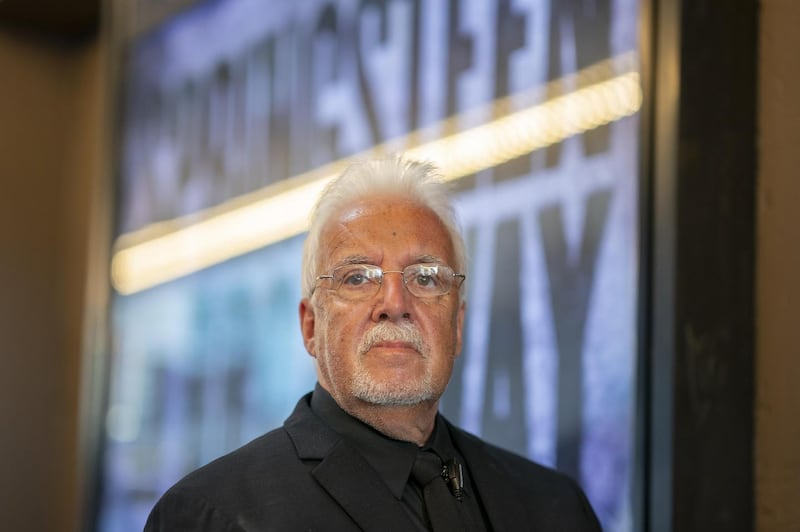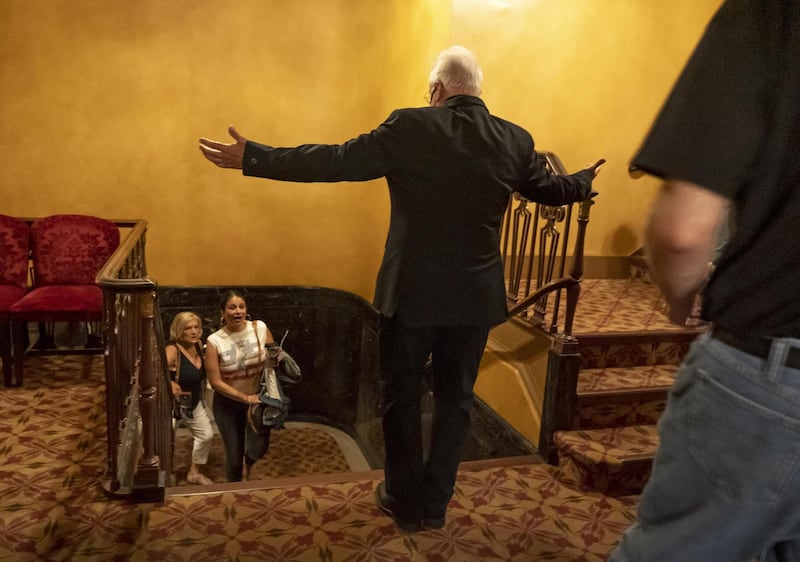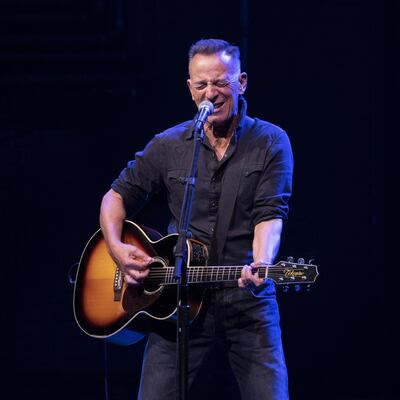Jim Barry is masked and ready, perched at the top of the theatre stairs, cupping his hands around the outstretched smartphones so he can more easily make out the seat numbers.
"How you doing? Nice jacket."
"Go this way – it's an easier walk."
"Do you need help sir? The bathroom's right there."
I can tell somebody tapping me on the back where the bathroom is, while telling somebody in front of me where their seats are, and also waving to somebody in the corner
It is Saturday night at the St James Theatre, in New York. Bruce Springsteen is back on the stage. Fans are back in the seats. And, 15 months after the pandemic shut down Broadway, Barry, who has worked as an usher at the St James for 20 years, is back at work, doling out compliments and reassurance as he steers people towards the mezzanine, the restroom, the bar.
Springsteen on Broadway is essentially a one-man show, but its return has already brought back work for about 75 people at the St James – not only Barry but also another 30 ushers and ticket-takers, as well as merchandise sellers, bar staff, porters, cleaners, stagehands, box-office workers, a pair of managers and an engineer.
More shows, and jobs, will return in August and September as Broadway’s 41 theatres slowly come back to life. Ultimately, a Broadway rebound promises to benefit not just theatre workers but also hotel clerks and bartenders and taxi drivers and workers in the many industries that rely on theatre traffic, which can be considerable: in the last full season before the pandemic, 14.8 million people saw a Broadway show.

Barry, a gregarious 65-year-old grandfather from Staten Island, loves theatre, for sure, but also depends on the job for income and basic health insurance. “This job is not for everybody, but I made it my own,” he says.
Barry, a solidly built man with white hair who is often mistaken for a security officer, takes pride at being punctual, and jovial, and polite. “I can tell somebody tapping me on the back where the bathroom is, while telling somebody in front of me where their seats are, and also waving to somebody in the corner. It’s controlled insanity.”
As he returned to work following the shutdown, there were a few changes to master. He had to wear a mask – they are required for employees, but not patrons – and struggled to feel comfortable making small talk through the fabric. And tickets are now all digital, which meant his signature move, which involves passing tickets behind his back as he accepted, scrutinised and handed back the proffered stubs, was no longer useful; instead he needed to figure out how to quickly decipher all those different screen fonts.
Still, he is thrilled to be back. “No matter what happens, nothing can make me feel bad, because I’m back at my house, and the Boss is at my house,” he says. “It’s where I want to be.”

Barry took an unusual path to the theatre industry. For 27 years he had worked in banking, first as a teller and then as a bank officer in Times Square. He saw theatre, occasionally, and loved it. As a teenager he saw Danny Kaye in Two by Two, and later he saw Jesus Christ Superstar. ("I couldn't believe it was so fantastic.")
But the production he most excitedly remembers seeing is Grease, at the Royale Theatre; a friend got him access to walk on to the stage before the show. “It gave me the bug,” he says.
So when he decided he needed to earn more money, and began looking for a second job, he got in touch one of his customers at the bank, a woman who worked in payroll at Jujamcyn Theaters, which operates five Broadway theatres, including the St James. She asked if he’d be open to ushering.
That was in 2001. The first shift he worked was at a dress rehearsal for The Producers, which was about to open. “You know you belong when your body just gets enveloped in euphoria,” he says. He was hooked.
For years, he continued working full-time at the bank, while also working nights and weekends at the theatre; in 2016 he left the bank for good, and now he works six days a week at the theatre. (The shifts are short – a full usher shift is 4.5 hours, but at each show half the staff get to leave 30 minutes after curtain, which is two hours after their start time.)
It’s a union job, for which standard pay is $83.78 per show; Barry has the higher rank of director, so he makes about $710 a week, and supplements his income with social security and a small bank pension. He was kept afloat during the pandemic by unemployment payments; although he missed the theatre, he also was glad to have more time to spend with his girlfriend.

He has a bear of a commute – it can take up to two hours to get to work, depending on whether he drives or takes a bus, and how bad the traffic is. He arrives early, changes into his Jujamcyn uniform (black suit, black shirt, black tie, with a red J on the chest) and sits in a theatre doorway on West 44th Street that he calls “my stoop”, enjoying coffee and a roll and greeting passersby, sometimes posing for a picture with a passing actor.
Although he loves the theatre, seeing shows other than the ones he’s working is hard – he’s generally on duty when other shows are running. But he usually gets to the big ones. At his own theatre, he’s seen a mix of hits and flops. With the latter, he says, “you just feel bad for everybody”. And what if he doesn’t like a show he’s working? “We have the luxury of lobbies.”
There are, of course, headaches to manage – intoxicated patrons, and insistent videographers – but he prides himself on doing so with civility. For the cellphone scofflaws, whose ranks have swelled since he began, he will sometimes simply hover, which usually shames people into compliance; other times he will use a flashlight or a headshake to get someone’s attention, and once in a while he’ll say something like, “Please don’t do that. If they see you, I’m going to get in trouble.” At Springsteen on Broadway, no photos or videos are allowed until the bows.
How much does Barry love being part of the business? In March, sad not to be at work for his 20th anniversary at the theatre, he and his girlfriend drove into Times Square, and he posed for a photograph in front of each of the 41 Broadway theatres.
“There’s that old adage – when you love what you do, you never work a day in your life,” he says. “I am so lucky – I love to make people feel good about coming to our house.” – New York Times
















